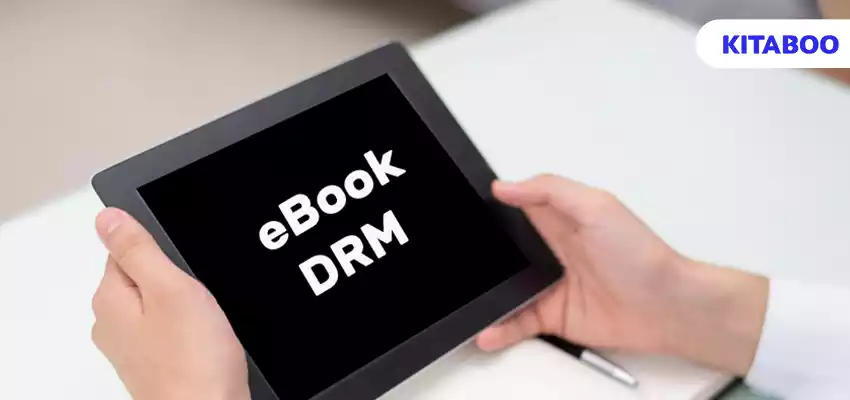
eBook DRM Essentials: Protect Your Work from Unauthorized Sharing
Summarize this blog with your favorite AI:
In the digital publishing industry, authors and publishers are more concerned about safeguarding their intellectual property than ever before. While digital publishing has its own set of perks, it also has risks that are hard to ignore, especially the fear of your work getting stolen.
There’s no denying that a strong fundamental strategy is needed to safeguard your eBook against unauthorized distribution, and that’s why creating DRM-protected eBooks is a smart move.
In this blog, we will discuss eBook DRM, its importance in preserving creative works, and its effectiveness in combating piracy.
In a few words, KITABOO is a cloud-based publishing platform that offers DRM features that enable creators to securely create, distribute, and protect their content in one centralized location.
Table of Content
II. Importance of Safeguarding eBooks
III. Understanding eBook DRM Systems
IV. Benefits of Implementing DRM
V. Implementing the Right DRM Protection
VI. Best Practices for Protecting Your eBooks
- Advanced Encryption Techniques
- Watermarking Strategies
- Regular System Updates
- Educate Readers about Copyright Laws
VII. Addressing Challenges and Limitations
VIII. Conclusion
What is a DRM System?
DRM, or Digital Rights Management System, is a shield that protects digital content from theft by controlling its access and usage rights.
Creating DRM Protected eBooks involves implementing encryption techniques to secure the content of your eBook and access controls to prevent unauthorized distribution and piracy.
Importance of Safeguarding eBooks
The increase in digital piracy poses a substantial threat to content creators, leading to revenue loss and devaluation of the work that they have spent their days and nights on.
By embracing DRM systems, authors can protect their ebooks from unauthorized distribution, thereby preserving their intellectual property rights and encouraging a sustainable digital publishing ecosystem.
Understanding eBook DRM Systems
The DRM system works as a gatekeeper that regulates access to your digital content and gives the rights only to those to whom you have provided access or those who have paid for it. These systems strengthen your eBook against infringement with their licensing mechanisms, ability to access controls, and ability to leverage encryption.
You can find ample DRM solutions available online to authors and publishers. A noteworthy DRM solution to give a shot is KITABOO, a cloud-based content platform that allows you to distribute interactive mobile-ready eBooks securely.
Benefits of Implementing DRM
Learning about all the stuff, whether the definition, importance, or understanding of the significance of the DRM system in an eBook, is essential.
However, being a publisher or an author, the things that mostly catch the attention are the benefits it can provide. Here are some benefits to get you a glimpse of how implementing a DRM system will help you:
- Enhanced Security: DRM protects ebooks against unauthorized access, taking care that only legitimate users can view or distribute content.
- Control Over Distribution: Authors can dictate how their ebooks are accessed and shared, empowering them to maintain control over pricing and distribution channels.
- Preservation of Revenue: By implementing DRM, authors safeguard their revenue streams by preventing piracy in publishing and protecting their works from unauthorized exploitation.
Implementing the Right DRM Protection
Authors must weigh various factors when evaluating DRM systems, including pricing, features, compatibility with different devices, and ease of use. A comparative analysis of popular DRM systems can help you make informed decisions customized to your specific needs and requirements.
After picking the right DRM protection, implementation is crucial to leverage its benefits. The process of creating DRM-Protected eBooks entails a systematic approach:
1. Prepare Your Manuscript
Format your manuscript correctly before applying for DRM protection. This involves organizing the content, ensuring proper layout, and preparing it for digital distribution.
2. Select the Right DRM System
Choose a DRM system that fits your needs. Consider factors like budget and features such as user authentication, access control, and encryption strength.
3. Apply Encryption
Encrypt your eBook files using the chosen DRM system to prevent unauthorized access and sharing. Encryption secures your content from piracy and ensures that only authorized users can access it.
4. Test Your Protection
Validate the effectiveness of your DRM protection through testing. Check if the encryption works as intended, assess user experience, and ensure that the DRM measures are functioning correctly to protect your eBook content.
Best Practices for Protecting Your eBooks
Beyond implementing DRM systems, authors can adopt additional measures to maintain ebook security:
1. Advanced Encryption Techniques
Implement cutting-edge encryption methods to strengthen eBook files against unauthorized access. Advanced encryption adds layers of security to protect your content effectively.
2. Watermarking Strategies
Embed unique watermarks in eBooks to prevent piracy and trace unauthorized distribution. Watermarks serve as a visible obstacle and aid in identifying copyright infringement.
3. Regular System Updates
Stay updated on emerging security threats and regularly update DRM systems to address vulnerabilities effectively. Keeping your systems up-to-date ensures continuous protection for your eBooks.
4. Educate Readers about Copyright Laws
Inform readers about copyright laws and stress the importance of purchasing legitimate copies. Educating your audience on copyright regulations can help prevent piracy and promote respect for intellectual property rights.
Addressing Challenges and Limitations
While DRM offers robust protection against piracy, it also presents challenges:
1. User Experience Concerns
Some users find DRM restrictions to be unmanageable, which can negatively impact their reading experience. It’s essential to balance protection with a seamless user experience to ensure readers can enjoy content without unnecessary barriers.
2. Criticism Over Restrictions
Critics argue that overly strict DRM controls may hinder legitimate usage by imposing restrictive access measures. Striking a balance between protection and accessibility is crucial to effectively addressing these concerns.
Conclusion
The significance of creating DRM-protected eBooks cannot be overstated in today’s digital era, where piracy remains a concern. By prioritizing the implementation of robust DRM systems, authors can safeguard their intellectual property rights effectively while encouraging a culture of ethical consumption in the digital publishing domain.
KITABOO emerges as a notable platform offering secure content distribution across platforms and protection mechanisms for authors and publishers. With its cloud-based system and DRM features, KITABOO provides a reliable means to safeguard digital content from unauthorized access and piracy.
The platform’s user-friendly interface and comprehensive tools make it a valuable asset for those seeking to protect their intellectual property in the digital landscape.
Discover how a mobile-first training platform can help your organization.
KITABOO is a cloud-based platform to create, deliver & track mobile-first interactive training content.



